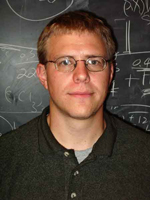Matthew Bierman

Matthew J. Bierman
Graduate Student, Materials Chemistry
Department of Chemistry
University of Wisconsin-Madison
Biographical Sketch
B.S. University of Wisconsin-La Crosse, Chemistry and Physics, 2003
PhD University of Wisconsin-Madison, 2004-2009
NSF CCI Postdoc Fellow at Caltech with Nate Lewis, Beginning Sept. 2009
Research
My research begins with using chemical knowledge to develop synthetic pathways to desired novel nanomaterials, followed by careful characterization using electron microscopy, synchrotron x-ray scattering and other techniques, and continues through the study of their materials dependent physical properties and application in proof of concept devices.
Dislocation driven nanowire growth. Most nanowire papers use one basic catalyst driven mechanism (vapor-liquid-solid; VLS) to account for growth, including cases were there is no direct evidence for this particular growth mechanism. I have discovered a novel nanowire growth mechanism, dislocation driven growth, that is the driving force for PbS pine tree nanowire structures. This mechanism has the potential to explain many nanowire growth papers, especially when the nanowires are free of catalyst or are prone to dislocations as in the case of SiC, ZnO, and GaN. The enhanced growth rate of the trunk over the VLS grown branches is due to the perpetual growth facet of the screw dislocation. The coexistence of both VLS and dislocation-driven growth mechanisms has additional impact in nanoscale hierarchy, which remains a vexing challenge to large scale utilization of nanoscale components.
Validation of Eshelby’s theory for the twist of a screw dislocation. This growth also provides experimental verification of the “Eshelby twist” theory for the rotation of a crystal lattice around a screw dislocation in a finite, 1-dimensional rod. Eshelby has used elasticity theory to calculate the twist of a crystal due the strain induced by a coaxial screw dislocation. This twist is represented as α = b/πR2, where α is the twist in radians/length, b is the screw Burgers vector magnitude, and R is the nanowire radius. The branching overgrowth makes this easy to observe, while the 1/R2 dependence of the Eshelby twist makes this is another phenomenon that is enhanced on the nanoscale.
Selected Publications and Presentations
0) Morin, S. A.; Bierman, M. J.; Tong, J.; Jin, S. “Mechanism and Kinetics of Spontaneous Nanotube Growth Driven by Dislocations”Science, 328 (5977) (2010) 476-480
1) Lau, Y.K. Albert; Chernak, Davin J.; Bierman, Matthew J.; Jin, Song; Formation of PbS Nanowire Pine Trees Driven by Screw Dislocations J. Am. Chem. Soc.131 (45) (2009) 16461-16471
2) Selinsky, Rachel; Keavney, David J.; Bierman, Matthew J.; Jin, Song; Element-Specific Magnetometry of EuS Nanocrystals Appl. Phys. Lett. 95 (202501) (2009)
3) Bierman, M. J.; Jin, S.; Potential Applications of Hierarchical Branching Nanowires in Solar Energy Conversion Energy Environ. Sci., 2009, 2, 1050-1059. (Invited Perspective).
4) Lau, Y.K. Albert; Chernak, Davin J.; Bierman, Matthew J.; Jin, Song; Epitaxial growth of hierarchical PbS nanowires, Journal of Materials Chemistry, 19 (2009) 934-940
5) Metz, Kevin M.; Mangham, Andrew N.; Bierman, Matthew J.; Jin, Song; Hamers, Robert J.; Pederson, Joel A.; Engineered Nanomaterial Transformation under Oxidative Environmental Conditions: Development of an in vitro Biomimetic Assay, Environmental Science and Technology, 43 (5) (2009) 1598-1604
6) Bierman, Matthew J.; Lau, Y.K. Albert; Kvit, Alexander V.; Schmitt, Andrew L.; Jin, Song; Dislocation-Driven Nanowire Growth and Eshelby Twist, Science, 320 (5879) (2008) 1060-1063
7) Bierman, M.J..; Lau, Y.K.A.; Jin, S.; Hyperbranched PbS and PbSe Nanowires and the Effect of Hydrogen Gas on Their Synthesis, Nano Lett. 7 (2007) 2907
8) Bierman, M.; Van Heuvelen, K.M.; Schmeisser, D.; Brunold, T.C.; Jin, S.; Ferromagnetic Semiconducting EuO Nanorods, Adv. Mater. 19 (2007) 2677
9) Lau, Y.K. Albert; Chernak, Davin J.; Bierman, Matthew J.; Jin, Song; Epitaxial growth of hierarchical PbS nanowires, Journal of Materials Chemistry, 19 (2009) 934-940
10) Metz, Kevin M.; Mangham, Andrew N.; Bierman, Matthew J.; Jin, Song; Hamers, Robert J.; Pederson, Joel A.; Engineered Nanomaterial Transformation under Oxidative Environmental Conditions: Development of an in vitro Biomimetic Assay, Environmental Science and Technology, (2009)
11) Szczech, J; Schmitt, A.L.; Bierman, M.J.; Jin, S.; Single-Crystal Semiconducting Chromium Disilicide Nanowires Synthesized via Chemical Vapor Transport, Chem. Mater. 19 (2007) 3238
12) 2006 MRS Fall National Meeting, (A) “Synthesis and Physical Properties of Ferromagnetic Semiconducting EuO Nanorods”, (B) “Nanorods of the Concentrated Ferromagnetic Semiconductor EuO: Synthesis and Physical Properties” M.J. Bierman and Song Jin, Boston, MA, November 27-December 2, 2006
13) 41st American Chemical Society Midwest Regional Meeting, “Synthesis and Physical Properties of Ferromagnetic Semiconducting EuO Nanorods”, M.J. Bierman and Song Jin, Quincy, IL, October 25-27, 2006
14) H.M. Kieler, M.J. Bierman, I.A. Guzei, P.J. Liska, R.W. McGaff, “Racemic iron(III) and cobalt(III) complexes containing a new pentadentate ‘‘helmet’’ phthalocyaninato ligand”, Chem. Comm., 3326-8, 2006
15) A.L. Schmitt, M.J. Bierman, D. Schmeisser, F.J. Himpsel, Song Jin, “Synthesis and Properties of Single-Crystal FeSi Nanowires”, Nano Lett., 6, 1617-21, 2006
16) B.F. Klindworth, M.J. Bierman, A. Bush, The 2+1 Dimensional Q/Q-bar Potential in Fourth Order Color-Dielectric Transverse Lattice QCD”, Los Alamos National Laboratory High Energy Physics—Phenomenology, 2002
